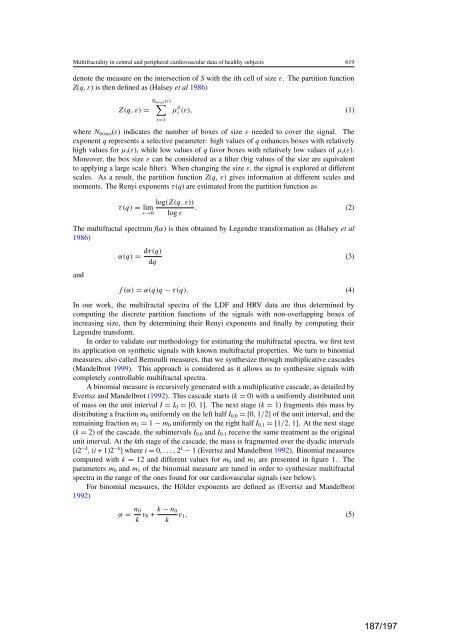a la physique de l'information - Lisa - Université d'Angers
a la physique de l'information - Lisa - Université d'Angers
a la physique de l'information - Lisa - Université d'Angers
You also want an ePaper? Increase the reach of your titles
YUMPU automatically turns print PDFs into web optimized ePapers that Google loves.
Multifractality in central and peripheral cardiovascu<strong>la</strong>r data of healthy subjects 619<br />
<strong>de</strong>note the measure on the intersection of S with the ith cell of size ε. The partition function<br />
Z(q, ε) is then <strong>de</strong>fined as (Halsey et al 1986)<br />
Z(q, ε) =<br />
Nboxes(ε) <br />
i=1<br />
μ q<br />
i (ε), (1)<br />
where Nboxes(ε) indicates the number of boxes of size ε nee<strong>de</strong>d to cover the signal. The<br />
exponent q represents a selective parameter: high values of q enhances boxes with re<strong>la</strong>tively<br />
high values for μi(ε), while low values of q favor boxes with re<strong>la</strong>tively low values of μi(ε).<br />
Moreover, the box size ε can be consi<strong>de</strong>red as a filter (big values of the size are equivalent<br />
to applying a <strong>la</strong>rge scale filter). When changing the size ε, the signal is explored at different<br />
scales. As a result, the partition function Z(q, ε) gives information at different scales and<br />
moments. The Renyi exponents τ(q) are estimated from the partition function as<br />
τ(q) = lim<br />
ε→0<br />
log(Z(q, ε))<br />
. (2)<br />
log ε<br />
The multifractal spectrum f(α) is then obtained by Legendre transformation as (Halsey et al<br />
1986)<br />
and<br />
α(q) = dτ(q)<br />
dq<br />
f(α)= α(q)q − τ(q). (4)<br />
In our work, the multifractal spectra of the LDF and HRV data are thus <strong>de</strong>termined by<br />
computing the discrete partition functions of the signals with non-over<strong>la</strong>pping boxes of<br />
increasing size, then by <strong>de</strong>termining their Renyi exponents and finally by computing their<br />
Legendre transform.<br />
In or<strong>de</strong>r to validate our methodology for estimating the multifractal spectra, we first test<br />
its application on synthetic signals with known multifractal properties. We turn to binomial<br />
measures, also called Bernoulli measures, that we synthesize through multiplicative casca<strong>de</strong>s<br />
(Man<strong>de</strong>lbrot 1999). This approach is consi<strong>de</strong>red as it allows us to synthesize signals with<br />
completely control<strong>la</strong>ble multifractal spectra.<br />
A binomial measure is recursively generated with a multiplicative casca<strong>de</strong>, as <strong>de</strong>tailed by<br />
Evertsz and Man<strong>de</strong>lbrot (1992). This casca<strong>de</strong> starts (k = 0) with a uniformly distributed unit<br />
of mass on the unit interval I = I0 = [0, 1]. The next stage (k = 1) fragments this mass by<br />
distributing a fraction m0 uniformly on the left half I0.0 = [0, 1/2] of the unit interval, and the<br />
remaining fraction m1 = 1 − m0 uniformly on the right half I0.1 = [1/2, 1]. At the next stage<br />
(k = 2) of the casca<strong>de</strong>, the subintervals I0.0 and I0.1 receive the same treatment as the original<br />
unit interval. At the kth stage of the casca<strong>de</strong>, the mass is fragmented over the dyadic intervals<br />
[i2 −k ,(i +1)2 −k ] where i = 0, ...,2 k − 1 (Evertsz and Man<strong>de</strong>lbrot 1992). Binomial measures<br />
computed with k = 12 and different values for m0 and m1 are presented in figure 1. The<br />
parameters m0 and m1 of the binomial measure are tuned in or<strong>de</strong>r to synthesize multifractal<br />
spectra in the range of the ones found for our cardiovascu<strong>la</strong>r signals (see below).<br />
For binomial measures, the Höl<strong>de</strong>r exponents are <strong>de</strong>fined as (Evertsz and Man<strong>de</strong>lbrot<br />
1992)<br />
α = n0<br />
k v0 +<br />
k − n0<br />
v1, (5)<br />
k<br />
(3)<br />
187/197


